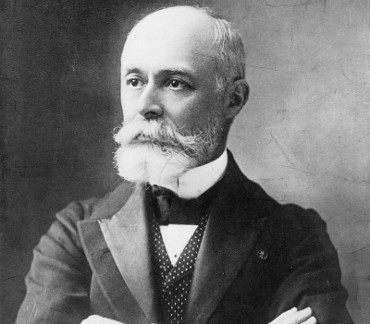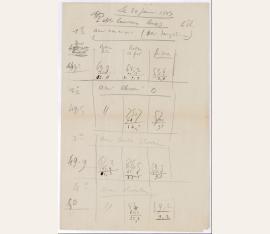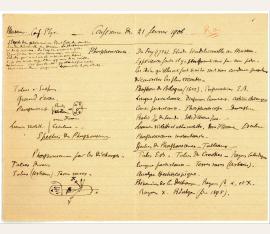French physicist and Nobel laureate (1852-1908). Autograph manuscript. N. p. 20.01.1883. Large 4to. 3½ pp. on bifolium. In pencil and black ink.
8.500 €
(47205/BN31949)
List in tabular form, possibly on infrared spectrum.
French physicist and Nobel laureate (1852-1908). "Conférence du Museum". Autograph manuscript. No place. 21.02.1906. Oblong 4to. 3 pp. With autograph sleeve.
9.500 €
(80956/BN52882)
In French, containing cues for an introductory lecture on the scientific history of phosphorescence, electromagnetic radiation, and radioactivity held at the museum of the military academy of Saint-Cyr. In his opening remarks Becquerel draws a connection between museums and the research on phosphorescence, also mentioning his father Edmond, who had been a professor at the National Museum of Natural History in Paris. He stresses the importance of the history of ideas in the natural sciences: "There are some phenomenona that seem traditionally to be researched at museums.
Phosphorescence is one of them. [Charles François de Cisternay] Du Fay worked on it in 1724. 50 years ago, my father started a series of research projects that have not been interrupted since. If I introduce you to some of these old experiments today it is because the ideas that they brought forward will lead us to the most recent discoveries." Following this historic approach, Becquerel mentions the first description of phosphorescence in 1602, du Fay's experiments with electric charges, the invention of the Crookes tube around 1870 which made Wilhelm Röntgen's discovery of X-rays in 1895 possible, the discovery of polonium and radium by his student Marie Curie and her husband Pierre in 1898, the differentiation of alpha, beta, and gamma rays by Ernest Rutherford between 1899 and 1903, and a variety of other important scientific contributions. Although the cues include a few diagrams and formulae, Becquerel's aim was clearly propaedeutic with a lecture tailored to a young audience. In his closing statement, he offers two vivid metaphors of the recently discovered electron: "Within an atom the electrons are as distant as the planets in the solar system. An electron is much smaller than a microscopic mosquito flying in the nave of a cathedral." - Lightly folded, in very good condition..
verkauft
Eigenh. Manuskript ohne U.
Autograph ist nicht mehr verfügbar
Henri Becquerel (1852–1908), Physiker und Nobelpreisträger. E. Manuskript ohne U. O. O. u. D. 2 SS. auf Doppelblatt. Gr.-4°. – Notizen zu einem Vortrag über die Geschichte der Maschinen („History [!] des machines“). Erwähnt werden neben Michael Faraday und dem von ihm i. J. 1831 entdeckten Prinzip der elektromagnetischen Induktion der amerikanische Erfinder Edward Samuel Ritchie (1814–1895), der englischen Ingenieur Henry Wilde (1833–1919) – der den selbstladenden Dynamo („magnet-elektrische Maschine“ oder „magnetelektrische Erregermaschine“) erfunden hatte und dessen diesbezüglichen Aufzeichnungen 1866 von Faraday der Royal Society überbracht worden waren –, ein „C. Varley“ – wohl der Elektroingenieur Cromwell Fleetwood Varley (1828–1883), ein Bruder des Elektrotechnikers Samuel Alfred Varley (1832–1921) –, der Physiker Charles Wheatstone (1802–1875), der Begründer der Elektrotechnik Werner von Siemens (1816–1892), der italienische Physiker Antonio Pacinotti (1841–1912), der belgische Konstrukteur und Erfinder Zénobe Théophile Gramme (1826–1901) sowie der amerikanische Erfinder und Unternehmer Thomas Alva Edison (1847–1931). Der Zweck von Becquerels Notizen dürfte wohl darin zu suchen sein, daß er hier die relative Gleichzeitigkeit von Innovationen in der Energieerzeugung deutlich zu machen versucht. – Papierbedingt leicht gebräunt und mit kleinen Randläsuren; Bl. 1 mit zeitgenössisch notierten, wohl aber nicht von Becquerel stammenden mathematischen Formeln.


